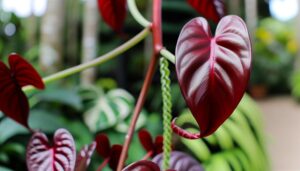What Should I Know About the Roots of a Pink Princess Philodendron?
The roots of *Philodendron erubescens* 'Pink Princess' are fundamental for optimal plant health. These roots include an epidermis, cortex, endodermis, and a vascular cylinder.
Healthy roots should exhibit a light tan to white hue and possess a firm, velvety texture. Lateral roots enhance nutrient absorption, while adventitious roots aid in water uptake.
Common issues like root rot from Phytophthora or Pythium require early detection and intervention. Proper watering and well-draining soil are crucial to prevent root diseases.
Maintaining the root system's health ensures the plant thrives. For a deeper understanding, more detailed information is available.
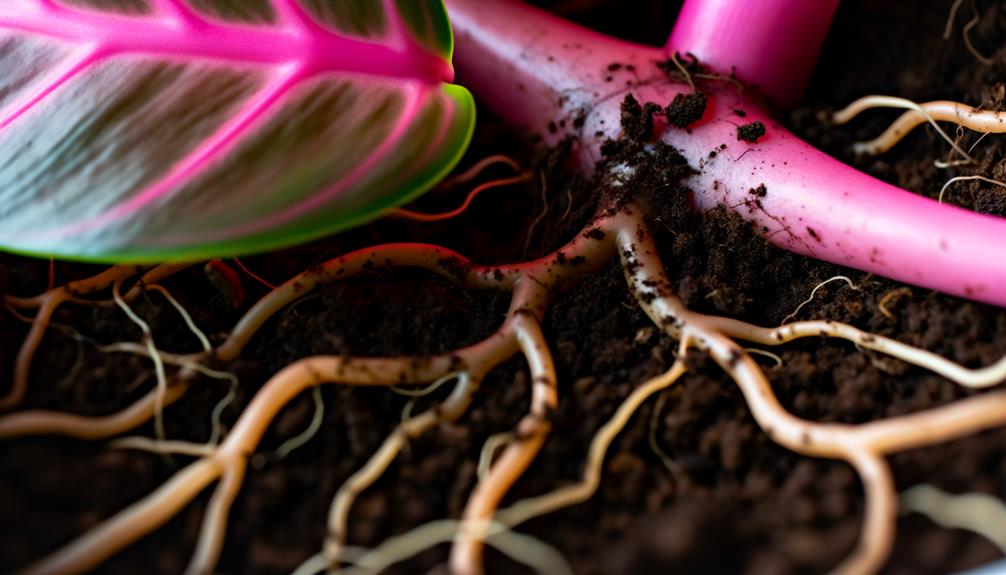
Key Takeaways
- Healthy roots are light tan to white, firm, and have a velvety texture.
- Root diseases like root rot can be caused by pathogens such as Phytophthora and Pythium.
- Roots consist of epidermis, cortex, endodermis, and vascular cylinder, essential for nutrient absorption and anchorage.
- Proper watering and well-draining soil are critical to prevent root diseases.
- Adventitious roots and root hairs significantly enhance water and nutrient uptake.
Importance of Healthy Roots
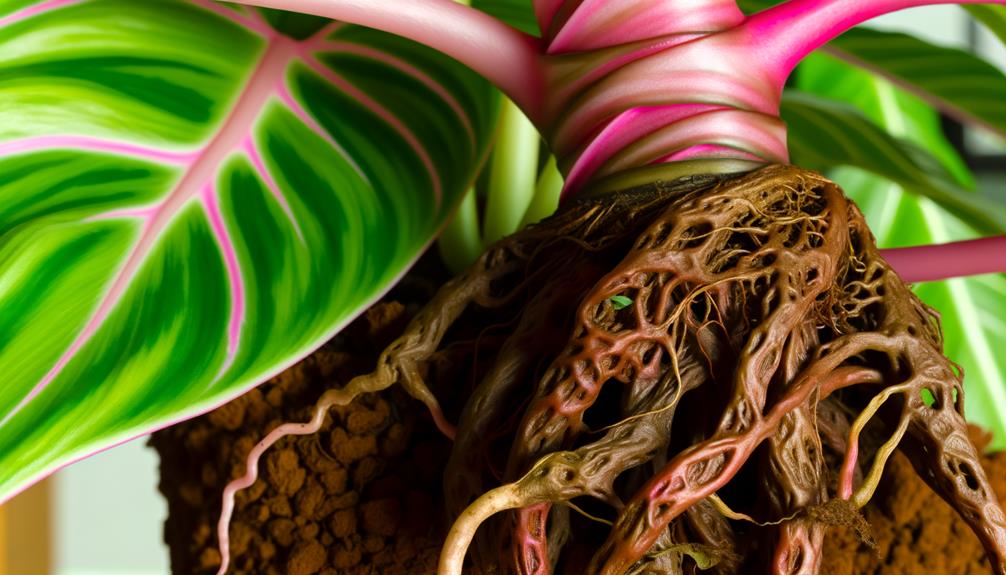
The health and strength of the root system in a Philodendron erubescens 'Pink Princess' are essential to its overall well-being and growth.
A robust root system enhances nutrient and water uptake, necessary for the plant's metabolic functions and cellular processes. Proper root function guarantees the efficient transport of crucial minerals, such as nitrogen (N), phosphorus (P), and potassium (K), which are indispensable for photosynthesis and energy production.
Additionally, healthy roots anchor the plant firmly in its growing medium, providing structural stability. Pathogen resistance is also heightened in well-maintained roots, reducing susceptibility to root rot (Phytophthora spp.) and other soil-borne diseases.
Maintaining the best root health is vital for the Philodendron erubescens 'Pink Princess' to thrive.
Anatomy of Philodendron Roots
The roots of Philodendron erubescens, commonly known as the Pink Princess Philodendron, exhibit a complex anatomical structure consisting of the epidermis, cortex, endodermis, and vascular cylinder.
These structures collectively facilitate critical functions such as nutrient absorption, anchorage, and storage.
Understanding the growth patterns and physiological roles of these root components is essential for optimizing plant health and development.
Root Structure Overview
Philodendron roots, specifically those of the Philodendron erubescens 'Pink Princess', exhibit a complex structure comprising primary, secondary, and adventitious roots. The primary root, or taproot, extends directly from the seed, providing initial stability and nutrient uptake.
Secondary roots, or lateral roots, branch off from the primary root, enhancing the plant's ability to absorb water and minerals. Adventitious roots, emerging from non-root tissues such as stems, contribute to the plant's overall anchorage and support.
These roots are characterized by several distinct features:
- Root Cap: Protects the growing tip of the root.
- Epidermis: Outermost layer absorbing water.
- Cortex: Facilitates the transport of nutrients to the vascular tissues.
Understanding this anatomy is important for effective cultivation and care.
Function and Growth
How do the various root structures of Philodendron erubescens 'Pink Princess' contribute to its function and growth, particularly regarding nutrient absorption and stability?
The primary root, or taproot, anchors the plant, providing essential stability.
Lateral roots extend from the taproot, enhancing the surface area for nutrient absorption from the soil.
Adventitious roots, which develop from non-root tissues, play an essential role in water and nutrient uptake, especially when the plant is propagated through cuttings. These roots also exhibit positive geotropism, aiding in anchorage and support.
The root hairs, found on the epidermis of both primary and lateral roots, further increase the absorptive capacity by maximizing contact with soil particles, thereby optimizing the uptake of minerals and water necessary for vigorous growth.
Recognizing Healthy Roots
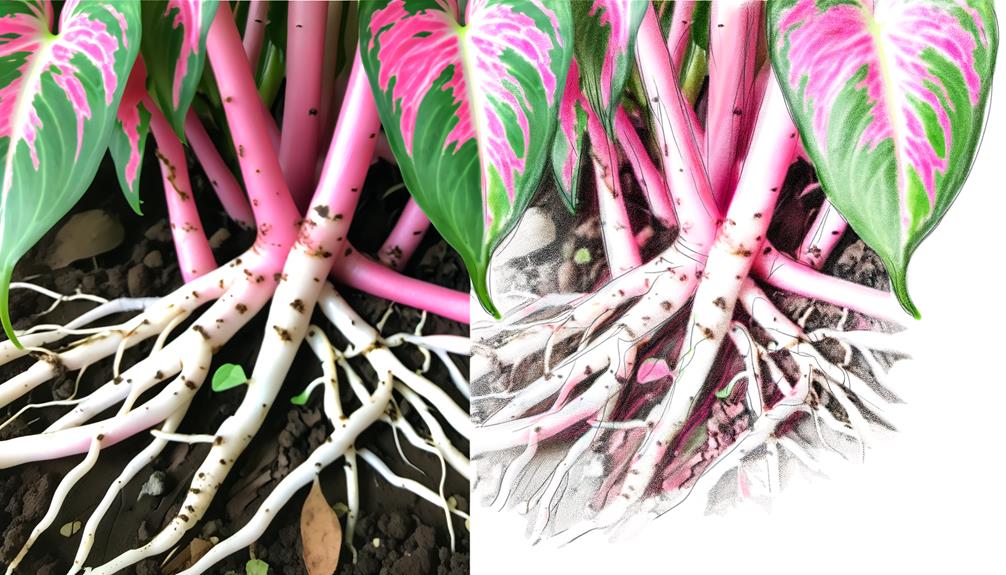
Identifying healthy roots in a *Philodendron erubescens* 'Pink Princess' involves evaluating key indicators such as root color and physical characteristics.
Best roots display a light tan to white hue, indicating proper nutrient absorption and oxygenation.
Furthermore, healthy roots should feel firm to the touch and have a slightly velvety texture, showing strong cellular integrity and no presence of pathogens.
Root Color Indicators
The presence of creamy white to light tan roots in the Pink Princess Philodendron (Philodendron erubescens) serves as a primary indicator of root health and robustness. This coloration signifies optimal physiological conditions, ensuring efficient nutrient and water uptake.
Deviations in root color often signal underlying problems. To accurately gauge root health, consider the following indicators:
- Consistent Coloration: Uniform creamy white to light tan hues throughout the root system are indicative of a thriving plant.
- Absence of Dark Spots: Dark brown or black spots suggest potential issues such as rot or fungal infections.
- Healthy Growth Tips: New root tips should display a vibrant, lighter shade, signifying active growth and nutrient absorption.
These visual cues are essential for monitoring the well-being of your Philodendron.
Firmness and Texture
In addition to color, the firmness and texture of the roots of Philodendron erubescens serve as critical indicators of their overall health and functionality. Healthy roots exhibit a firm, turgid structure, indicative of efficient water and nutrient uptake.
Conversely, roots that are mushy or soft to the touch could signal rot or disease, often caused by overwatering or poor drainage. The epidermis of healthy roots should be smooth and unblemished, while any presence of sloughing or peeling layers may indicate underlying issues.
Examining these tactile characteristics allows for early intervention, ensuring the plant's best growth and resilience. Regular inspection and maintenance of root health are essential for sustaining the vibrancy and aesthetic appeal of the Pink Princess Philodendron.
Identifying Root Problems
Diagnosing root problems in *Philodendron erubescens* 'Pink Princess' involves examining symptoms such as root rot, discoloration, and compromised structural integrity. Visual inspection and tactile assessment are critical for early detection.
Key indicators include:
- Root Rot: Affected roots appear mushy, brown, or black, often emitting a foul odor.
- Discoloration: Healthy roots are typically white or light tan; any deviation, like yellowing or browning, signals distress.
- Structural Integrity: Healthy roots should be firm and resilient. Soft or brittle roots indicate underlying issues.
Regularly monitor the root system, especially when repotting or if the plant exhibits stunted growth or wilting. Addressing these symptoms promptly can prevent severe damage and promote vigorous growth of *Philodendron erubescens* 'Pink Princess'.
Common Root Diseases
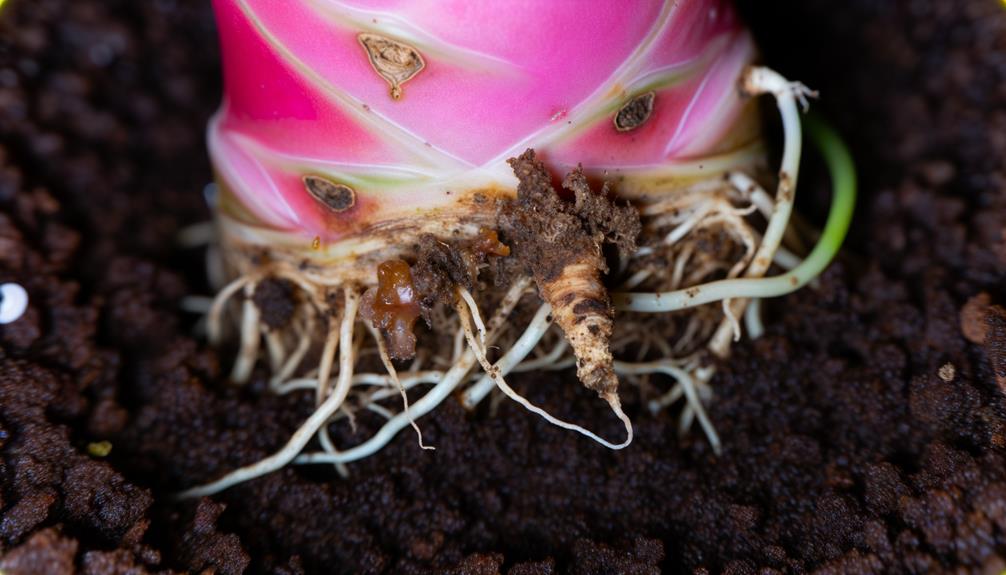
Common root diseases affecting the Pink Princess Philodendron (Philodendron erubescens) include Phytophthora and Pythium-induced root rot, characterized by dark, mushy roots and stunted growth.
Fungal infections such as Fusarium wilt present with chlorosis, necrosis, and wilting of foliage.
Effective prevention and treatment strategies encompass proper drainage, sterilization of tools, and the application of fungicides containing active ingredients like thiophanate-methyl or azoxystrobin.
Root Rot Causes
Root rot in Pink Princess Philodendron (Philodendron erubescens 'Pink Princess') is primarily caused by pathogenic fungi and waterlogged soil conditions, particularly involving species like Pythium, Phytophthora, and Rhizoctonia. These pathogens thrive in overly damp environments, leading to the deterioration of root tissues and plant health.
Key factors contributing to root rot include:
- Overwatering: Continuous saturation of the soil limits oxygen availability, creating an anaerobic environment conducive to fungal growth.
- Poor Drainage: Inadequate soil drainage systems prevent excess water from escaping, fostering conditions favorable for these pathogens.
- Contaminated Soil: Introduction of infected soil or plant material can spread these fungi, initiating root rot.
Understanding these causes is essential for implementing effective preventative measures and ensuring the health of your Pink Princess Philodendron.
Fungal Infections Symptoms
Recognizing the symptoms of fungal infections in Pink Princess Philodendron is imperative for early detection and treatment, with indicators such as discolored, mushy roots and stunted growth often signaling the presence of pathogens like Pythium, Phytophthora, and Rhizoctonia. These pathogens thrive in overly moist soil conditions, disrupting the plant's nutrient uptake and causing root decay. Detailed inspection reveals the following symptomatic traits:
| Pathogen | Symptomatic Traits |
|---|---|
| Pythium | Water-soaked, limp roots |
| Phytophthora | Brown, brittle roots |
| Rhizoctonia | Reddish-brown root lesions |
| Fusarium | Yellowing leaves, root wilting |
| Verticillium | Vascular discoloration |
A systematic approach to identifying these pathogens allows for precise diagnosis and informed management, ensuring the health and longevity of the Pink Princess Philodendron.
Prevention and Treatment
Effectively preventing and treating common root diseases in Pink Princess Philodendron necessitates a multifaceted approach, incorporating proper cultural practices, timely chemical interventions, and biological controls to mitigate the impact of pathogens such as *Pythium*, *Phytophthora*, *Rhizoctonia*, *Fusarium*, and *Verticillium*.
Critical steps include:
- Cultural Practices: Ensure well-draining soil, avoid overwatering, and maintain ideal humidity levels to prevent waterlogged conditions conducive to pathogens.
- Chemical Interventions: Utilize fungicides such as metalaxyl or mefenoxam specifically targeting *Pythium* and *Phytophthora*, ensuring application as per manufacturer's guidelines.
- Biological Controls: Incorporate beneficial organisms like *Trichoderma* spp. to outcompete harmful fungi, thereby promoting root health and disease resistance.
These measures collectively enhance plant resilience and root integrity.
Root Rot: Prevention and Treatment
Preventing root rot in the Pink Princess Philodendron (Philodendron erubescens) requires strict control of watering practices and ensuring well-draining soil conditions. Overwatering is the primary cause of root rot, a condition where roots become blackened and mushy due to fungal pathogens like Pythium spp. and Phytophthora spp.
Treatment involves removing affected roots and repotting in a fresh, sterile substrate. Utilizing a fungicide may also be necessary to eradicate residual pathogens.
| Indicator | Healthy Roots | Rot-Affected Roots |
|---|---|---|
| Color | White or light tan | Black or dark brown |
| Texture | Firm and resilient | Mushy and soft |
| Smell | Fresh, earthy | Foul, decaying |
| Overall Plant Health | Vigorous growth and foliage | Wilting, yellowing leaves |
Regular monitoring and adherence to proper care practices are essential for preventing recurrence.
Soil Requirements
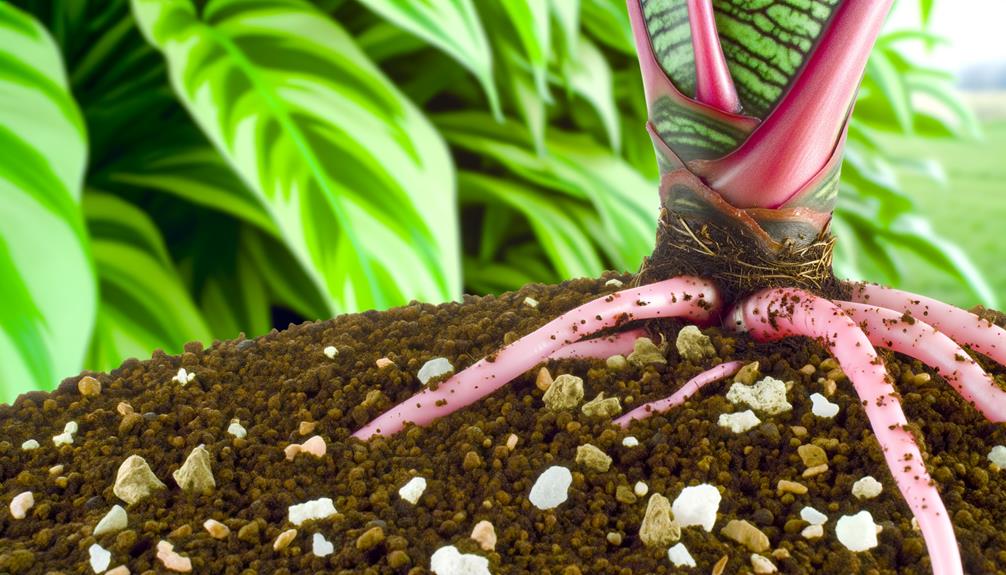
The ideal soil for a Pink Princess Philodendron (Philodendron erubescens) must be well-draining, with a composition that balances moisture retention and aeration to prevent waterlogged conditions. This delicate balance is critical for maintaining healthy root systems and avoiding root rot.
A recommended soil mix includes:
- Peat Moss: Enhances moisture retention while remaining lightweight and aerated.
- Perlite: Improves drainage and prevents soil compaction, facilitating root growth.
- Bark: Adds structure and promotes air circulation around the roots.
These components ensure the substrate remains porous, providing the roots with necessary oxygen. Additionally, a slightly acidic to neutral pH (6.0-7.0) is optimal. This soil composition supports the Pink Princess Philodendron's robust growth and vibrant foliage, essential for its ornamental appeal.
Watering Guidelines
Proper watering is crucial for the health of a Pink Princess Philodendron (Philodendron erubescens), as both overwatering and underwatering can lead to harmful effects on its root system and overall health. Best hydration involves maintaining a balance where the soil remains consistently moist but not waterlogged.
Using a moisture meter can help in determining when to water; typically, the top 1-2 inches of soil should dry out between waterings. Overwatering can cause root rot (Pythium spp.), while underwatering can lead to desiccation and reduced nutrient uptake.
Watering should be done using room-temperature, dechlorinated water to avoid root shock. Monitoring humidity levels, ideally between 60-80%, can further support the plant's hydration needs and promote strong root development.
Pot Size and Drainage
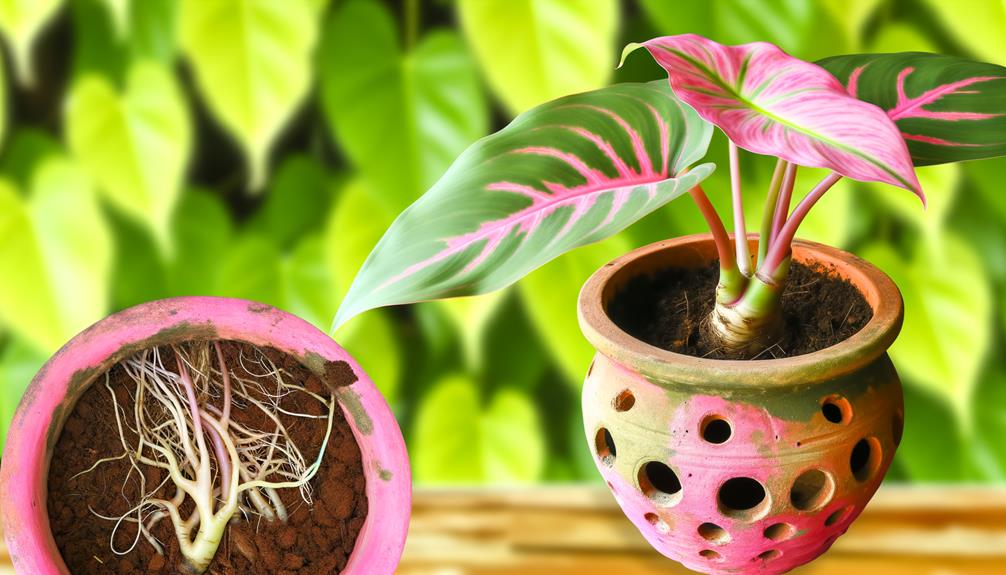
Selecting an appropriate pot size and optimizing adequate drainage are fundamental to maintaining the ideal root health of Pink Princess Philodendron (Philodendron erubescens), as these factors directly influence water retention and root aeration. The best pot size should accommodate the root system without causing crowding or excessive soil retention, which can lead to root rot.
Key considerations include:
- Pot Size: Choose a pot that is slightly larger than the root ball to allow for growth while preventing waterlogging.
- Drainage Holes: Optimize the pot with sufficient drainage holes to facilitate water flow and prevent stagnation.
- Soil Type: Utilize a well-draining, aerated soil mix, such as one containing perlite or orchid bark, to enhance root oxygenation and prevent compaction.
These measures optimize the healthy development of Philodendron erubescens roots.
Repotting Tips
Repotting a Pink Princess Philodendron (Philodendron erubescens) involves carefully moving the plant to a slightly larger container to accommodate its growing root system while ensuring minimal stress and best health.
Select a pot that is 1-2 inches larger in diameter than the current one, ensuring it has adequate drainage holes to prevent waterlogging and root rot.
Utilize a well-draining, nutrient-rich potting mix, ideally containing components such as peat moss, perlite, and orchid bark.
Gently remove the plant from its existing pot, taking care not to damage the roots. Loosen any compacted roots and place the plant in the new container, filling it with fresh soil.
Water thoroughly to settle the soil and eliminate air pockets.
Propagating With Roots
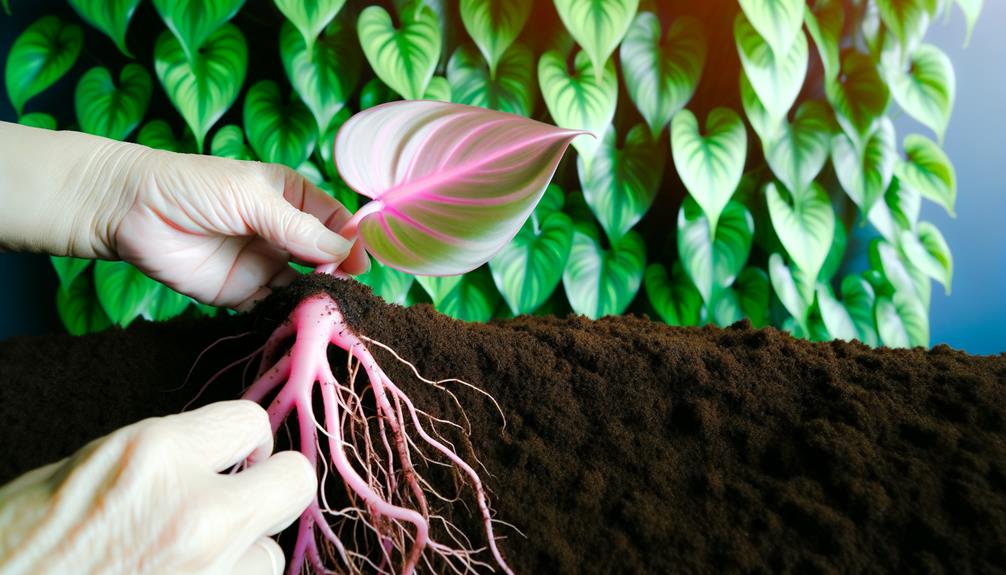
Propagation of the Pink Princess Philodendron (Philodendron erubescens) through root division involves carefully separating the root mass into smaller sections, each containing at least one healthy stem and root system, to guarantee successful establishment in new growth mediums. This method ensures genetic consistency and maintains the plant's variegated foliage.
To achieve best results, follow these steps:
- Preparation: Sterilize tools to prevent pathogen transmission and select a healthy mother plant.
- Division: Gently remove the plant from its pot, shake off excess soil, and use a sharp, clean knife to divide the root mass.
- Transplanting: Place each section into a well-draining potting mix, making sure roots are adequately covered and watered.
Proper aftercare, including indirect light and humidity, is essential for successful propagation.
Conclusion
Conclusively, the importance of *Philodendron erubescens* 'Pink Princess' roots serves as the foundation on which the overall health of the plant thrives.
A thorough understanding of root anatomy, coupled with careful observation for signs of disease and adherence to best watering and repotting practices, guarantees strong growth.
Just like a chain is only as resilient as its most vulnerable part, the plant's health depends on the attentive care of its root system, highlighting its crucial role in horticultural triumph.

